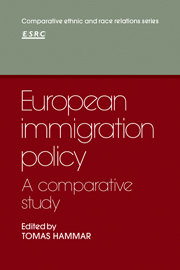9 - Immigration regulation and aliens control
Published online by Cambridge University Press: 05 November 2011
Summary
Immigration regulation is the control that a sovereign state exercises over the entry of foreign citizens and their access to residence and employment. As mentioned previously, most countries in Western Europe developed organized systems of immigration regulation at around the same time in the early 1900s. During periods of severe unemployment in the 1920s and 1930s, immigration control was strictly applied in protection of the national labor market. But we have seen that a new period of economic liberalism followed after the Second World War, once more liberalizing immigration control and opening the way for a great increase in labor migration.
Since aliens laws entrusted administrative bodies with great discretionary powers, it was not necessary in most countries to make amendments to these laws each time a more strict or a more liberal immigration regulation was introduced. What was needed was only a change in the application of existing provisions of the laws. But in Britain new legislation was continuously introduced in order to limit the size of colonial immigration.
In this chapter we shall compare regulation both before and after the turning point in the early 1970s, and discuss what kind of regulation has been used in countries with guestworker systems and in those countries with a system of permanent immigration. We shall also ask why Germany has not been willing to acknowledge a large, de facto permanent immigration, and why Sweden has not applied a guestworker system.
- Type
- Chapter
- Information
- European Immigration PolicyA Comparative Study, pp. 249 - 262Publisher: Cambridge University PressPrint publication year: 1985
- 5
- Cited by



